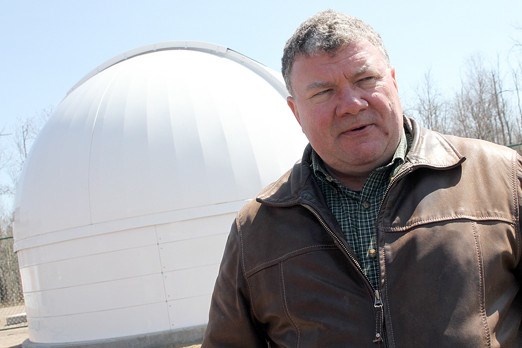Fort William Historical Park may seem like an odd fit for a celestial observatory, but the two actually go hand-in-hand, says a park spokesman.
Marty Mascarin said it’s a natural fit for programming already in place dealing with navigation, cartography and Aboriginal lore.
“All of these themes connect to the stars. And David Thompson, one of Canada’s greatest explorers, happened to be a Norwester. And we have an excellent example of his work in the Great Hall with a six-by-six-foot map covering about three million square miles that took about 20 years to complete,” Mascarin said.
“It’s a nice combination of heritage with a nice contemporary operation, so we’re really excited about this.”
Construction on the facility, which includes an adjacent classroom, is nearing completion, though no opening date for the observatory has yet been set.
Mascarin said park officials are hoping the 24-inch telescope, housed inside a white dome, with room for several star gazers at any given time, will also attract a different type of tourist to FWHP.
“There is a vast interest and an increase in astronomy in terms of learning vacations,” he said. “So you see a lot of RVers bringing telescopes with them. They’re going to dark places where they can actually view the skies.
“So we’re hoping to capitalize on that offering too, with our somewhat growing RV park that we have h
ere.”
There will be challenges, no doubt, Mascarin said, noting Thunder Bay’s location on the time-zone map puts the region at a bit of a disadvantage.
Geographically speaking the city should likely follow Central time, but the desire to remain on even ground with Toronto means the decision was made to keep Thunder Bay on Eastern time. This means later sunsets, Mascarin said.
“We do have a lot of daylight here in Thunder Bay until late in the evening,” Mascarin said. “But one of the advantages we have here with the set-up is a special camera that will be affixed to the telescope. So we can still scan the night skies and during the daytime, with education and community groups, or even with our RVers, we can still present some real-time visuals of what’s been going on the night before.
“If there’s anything of particular interest, we can have a recording of that to present to those people as they arrive here at the Fort.”
The annual Perseids meteor shower, which takes place each August, is a perfect example of that, he said.
“We can be set up to anticipate those kinds of phenomena and record them accordingly,” Mascarin said. “Obviously with it being so late at night, there will be a restricted audience for that type of thing. The video camera will be a tremendous boost to that type of programming.”
The adjacent classroom should be able to accommodate about 30 students at a given time, outfitted with computers and other learning materials to augment the telescope.
The 15-foot dome, built in conjunction with the local chapter of the Royal Astronomical Society will make it the largest observatory between Alberta and Southern Ontario.
Sign in or register
- Messages
- Post a Listing
- Your Listings
- Your Profile
- Your Subscriptions
- Your Likes
- Your Business
- Support Local News
- Payment History
Registered Users
Already have an account?
New Users
Create a free account.
